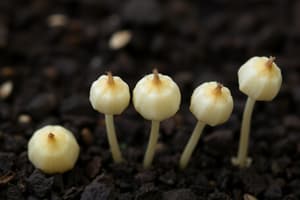Podcast
Questions and Answers
What are some factors that can break dormancy in seeds?
What are some factors that can break dormancy in seeds?
Exposure to a single factor at the requisite intensity for an appropriate period of time, fluctuating conditions such as diurnal changes of soil temperature or the diurnal cycle of light and darkness, seasonal cycle of temperature, exposure to two or more distinct factors such as light and an appropriate temperature range, or to ethylene at an appropriate temperature.
How does germination relate to the breaking of dormancy?
How does germination relate to the breaking of dormancy?
Germination follows the breaking of dormancy.
What are some examples of diurnal fluctuations that can break dormancy?
What are some examples of diurnal fluctuations that can break dormancy?
Diurnal changes of soil temperature or the diurnal cycle of light and darkness.
In what ways can dormancy breaking result from the seasonal cycle of temperature?
In what ways can dormancy breaking result from the seasonal cycle of temperature?
How might dormancy be broken in a more complex situation?
How might dormancy be broken in a more complex situation?
Flashcards are hidden until you start studying
Study Notes
Breaking Dormancy in Seeds
- Environmental factors can break seed dormancy, including light, temperature, water, and oxygen
- Mechanical scarification, such as scratching the seed coat, can also break dormancy
- Chemical scarification, such as treating seeds with acid, can break dormancy by damaging the seed coat
Germination and Dormancy
- Germination is the process by which a seed begins to grow, which occurs after dormancy is broken
- Breaking dormancy is a necessary step for germination to occur
- If dormancy is not broken, germination will not occur
Diurnal Fluctuations
- Diurnal fluctuations in temperature can break dormancy
- For example, daytime warming and nighttime cooling can stimulate germination
- Diurnal fluctuations in light can also break dormancy, with seeds responding to specific wavelengths and intensities
Seasonal Temperature Cycles
- Seasonal changes in temperature can break dormancy, such as winter cold stratification
- This type of dormancy breaking is often seen in seeds that require cold winter temperatures to germinate
- Temperature cycles can also break dormancy through the process of thermal after-ripening
Complex Situations
- Dormancy can be broken in complex situations, such as in seeds that require multiple environmental cues to germinate
- For example, seeds may require both cold stratification and light exposure to break dormancy
- In these situations, the combination of environmental cues can break dormancy and trigger germination
Studying That Suits You
Use AI to generate personalized quizzes and flashcards to suit your learning preferences.




